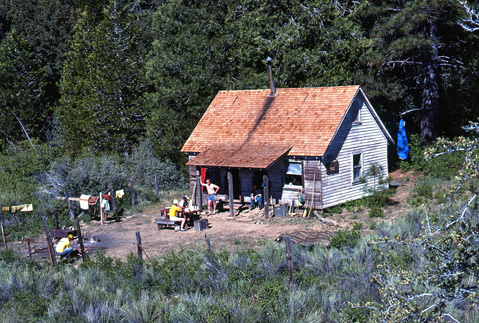The Man Who Burned Madulce Cabin Down
On Dominick Cosmo Roppoccio and Other Backcountry Hermits

On October 11, 1999, Forest Service mountain control coordinator Brian Thielst received a call: Someone had set fire to the historic cabin atop Madulce Peak. Thielst calmly got in the helicopter and headed up the mountain — he already knew who had done it. “All the fire guys were saying there’s a crazy nut down here, ranting and raving,” recalls Thielst. “I went down there and said, ‘I know who it is.’”
He was right. Thielst landed to find Dominick Cosmo Roppoccio standing alone, his backpack and clothing engulfed in the inferno. The longtime backcountry resident casually offered his hands, and the arrest was effortless.
The arson attained legendary status amid backcountry enthusiasts, who still share stories about a “wild man of the woods” that frightened and threatened hikers journeying into the San Rafael and Dick Smith wildlands. Yet Thielst and those who had closer encounters with Roppoccio remember him as a kind, hard-working man, one who was deeply disturbed from his service in Vietnam and wary of people. The burning was a final cry for help from a tormented mind.
Though the Chumash populated villages throughout what we now call the backcountry, very few people in contemporary times have managed to live there for long. Hot, vast, and often waterless, it is not the most hospitable of environments. “You’d have to be truly crazy to even attempt to live out there,” said Diane Soini, owner of santabarbarahikes.com.
Yet over the years, several have, often residing in the seldom-visited campgrounds bordering the wilderness. David Welby, a former Forest Service law-enforcement officer, spent a great deal of time looking after the many homeless who would populate Mono Camp and the camps along Paradise Road. “I tried to help people whenever I could,” said Welby. “Sometimes that was letting some people camp longer than they should, sometimes it meant giving them money or food to help them out.” The homeless were good stewards of Mono Camp, he said, and Roppoccio the main caretaker.
Sometimes, though, folks got out of control. In the mid-’90s, a drunken homeless individual raced his car around Mono Camp, killing his own dog and narrowly avoiding a tent full of people before striking a fire pit and triggering an engine explosion. Then there were the many poachers, marijuana growers, and archaeology thieves who troubled the backcountry in the ’80s and ’90s, though their numbers have thinned.
Few attracted the attention of law enforcement like Roppoccio, who gradually moved from Mono to longer backcountry stints. Carrying a .22, he would hunt quail (for which he was cited) and reside in the several Forest Service shelters, scaring away hikers and even scrawling “Kill the ranger” on signs. “He thought the FBI was going to arrest or kill him,” Welby recalled.
Thielst followed Roppoccio’s trail for years and got him a job as a concessionaire in Paradise Canyon (which he eventually left). He believes the scare tactics were largely just to push people away. “I thought it was more of an act. He was pretty functional, he could outwork five or six guys, but other people drove him crazy,” he said. “He was a little off because of PTSD, but … he was a great guy. He liked doing his own thing.”
Lacking medication, Roppoccio began to hallucinate more and hear voices. At Madulce, Thielst said, “He just wigged out.”
Roppoccio was sent to a veterans’ hospital down south. From there, his trace peters out. Not even Thielst knows where his old friend has gone. Here’s hoping that, wherever he is, he has found the peace that for so long evaded him — among people or, more likely, alone again.



